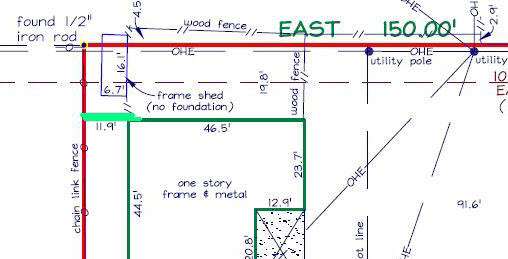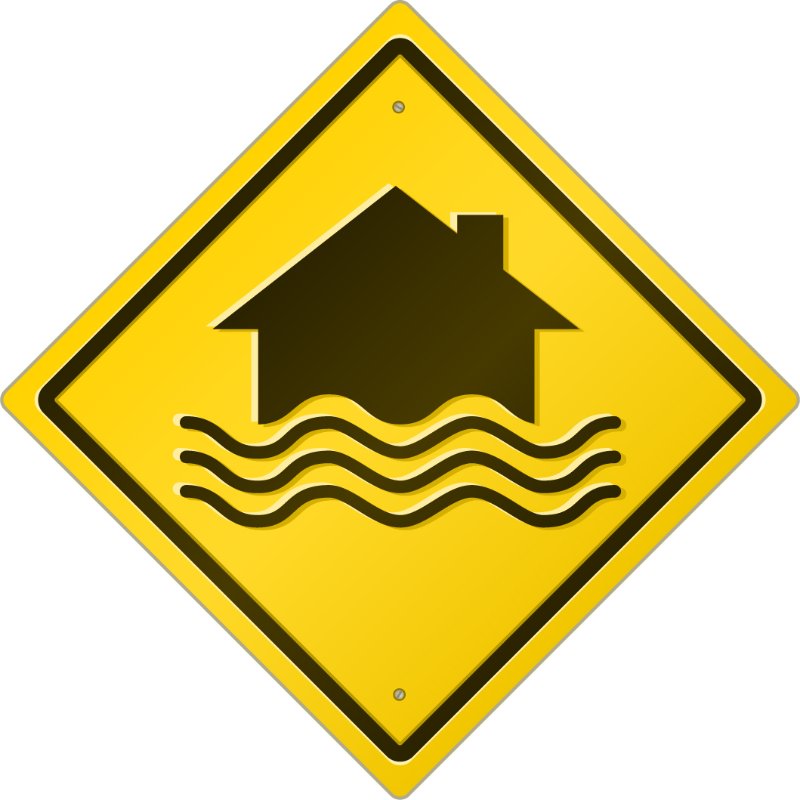Your property and house may be your single largest purchase in your life. You should protect it with the diligence that you would a stack of gold. Here are a half dozen things you should know about your property.
- Where are the property corners/property lines? And, what is marking the corners?
- Are there any encroachments over my property lines? If so, how far? Are these encroachments by me onto my neighbor or vice versa?
- Are there easements across my land?
- Am I in a flood hazard zone?
- Do I have a copy of my deed?
- Do I have a drawing from the last survey?
Where are my Property Lines/Property Corners?
Property corners are usually marked by some type of permanent marker, like a rebar or metal pipe. Wooden stakes rarely mark your property corners, they are a witness to the metal corner that is probably buried underground near the stake. So, a little digging may be necessary to find your corner. Surveyors bury these corners to keep them from being hit by lawn mowers or pulled up by neighbors.
Your property lines run between two property corners. Most times property lines run in a straight line, though they could also be in a curve. Typically road right-of-ways are the most probable curved lines. By looking at the original plat of your property at the courthouse (for a subdivision lot) you can determine if any of your lines are curved.
If you are not in a platted subdivision, there should be a “metes & bounds” legal description on your deed to indicate the distances and any curved lines. If you don’t have a copy of the deed look County Probate or Recorders office.
Are There Encroachments Over My Property Lines?
An encroachment is anything man-made, owned by one landowner that is built over their property line between them and another owner. Common encroachments are driveways, retaining walls, fences, outbuildings, and utility lines. These encroachments can be in either direction. If your driveway encroaches onto your neighbors land, that is an encroachment onto them. It is more of a problem for them than you, technically. If this isn’t significant, and wouldn’t hinder you using your driveway, then it may not be worth bringing up to your neighbor. And, if a neighbor’s driveway, or fence, or other object encroaches barely (less than a 6-inches) then this may not be worth arguing over.
 Once an encroachment is found, there are numerous solutions. Moving the encroaching object is most times the easiest. If this will create a significant burden, then an easement can be written that indicates that both sides are aware of the encroachment and they are OK with it as long as it doesn’t setup any type of adverse possession claims later.
Once an encroachment is found, there are numerous solutions. Moving the encroaching object is most times the easiest. If this will create a significant burden, then an easement can be written that indicates that both sides are aware of the encroachment and they are OK with it as long as it doesn’t setup any type of adverse possession claims later.
Are There Easements Across My Land?
An easement is where one person or entity (a utility company for example) has a right to use your land, but doesn’t own that part of your land. Common easements are for sanitary sewers, water mains, storm drainage, power lines or other utilities, or access easements. An easement is for a specific purpose. A sanitary sewer easement cannot be used for a power line, unless an additional agreement is given by the landowner. You should know of any easements that are currently on your property. There is usually some type of recorded document of an easement.
There are also times when an unwritten easement has been “given” (acquiesced) by you not stopping the use. In one case I know of, a landowner allowed school children to cut through his yard for years and later when a new owner tried to stop this “trespass” he could not do so because it had been allowed to go on for so long a time.
Am I in a Flood Hazard Zone?
Flood Hazard Maps are created by FEMA to show the areas that are susceptible to flooding during a 1-percent chance storm event. You can find these flood maps by visiting the FEMA Map Service Center and entering your street address. Flood zones are determined by a certain elevation, the Base Flood Elevation (BFE), in the vicinity of your house. If the flood zone adjacent or on your property is anything other than Zone A, which has no BFE determined, then the surveyor has a flood elevation he can compare to your house elevation. You can learn more by visiting our elevation certificate page.

Do I Have a Copy of My Deed?
If you can’t find your deed, one can typically be found in the Probate or Recorders office at your local county courthouse. Some counties have these documents online and others require you to visit the courthouse. The record room is usually staffed by someone who can help you find your deed. Expect to pay a copying fee if you want to take a copy home with you.
You should have a copy of your deed if you want to hire a surveyor to find your property corners. If you live in a subdivision that is platted (the entire map is recorded in the Probate Office) you can get a copy of a portion of the plat map that covers your lot. Carrying a digital camera or camera on your phone is often preferable to a paper copy, and cheaper. Snap a picture of all parts of a subdivision plat for the surveyor.
Do I Have a Drawing from The Last Survey?
If you haven’t had a survey done on your property since you moved in you may have to ask the former owners for that. If they don’t have it, then you may have to rely on just the subdivision plat copy from the courthouse. If you did have a survey done, and you can’t find it, contact the surveyor who completed the survey and ask for an unsigned copy.
When you get a new survey completed, protect the survey drawing just like you would your other valuable papers. You may have paid hundreds or thousands of dollars for this survey and having a copy is extremely valuable to you if you had to have any additional survey work done in the future. A prior survey is an invaluable document for us surveyors trying to “retrace” your property lines.
Keith Maxwell is a licensed land surveyor and civil engineer in the State of Alabama. He has over 25 years’ experience in surveying property in the state. Contact him at 334-826-9540 for help with your property in Alabama.




